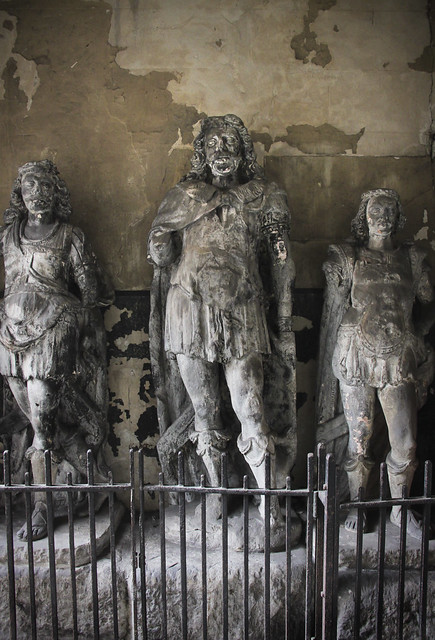Henslowe writes: R at kinge lude the 18 of Jenewarye 1593 ... xxijs
In modern English: Received at King Lud, 18th January, 1594 ... 22 shillings
Today, Sussex's Men introduced yet another play to the Rose audience. King Lud is now lost, but it must have been about the mythical pre-Roman king of the Britons after whom London is named. The audience would therefore have come to the theatre expecting a dramatization of local history. So, what might a play about King Lud have been like?
The legend of King Lud
The audience that gathered at the Rose would already have had a strong image of King Lud in their minds. Just a few years ago, in 1586, Ludgate, the great archway next to St Paul's Cathedral, had been enhanced with brand new statues of Lud and his two sons. You can still see these statues today: although Ludgate itself was demolished in the eighteenth century, Lud and his sons can be found standing awkwardly in the porch of the nearby church of St Dunstan in the West.

 |
| Ludgate, from Wenceslas Hollar's map of London (late 17th century) |
Lud was most famous for his beautification and enlargment of Troynovant, "which he compassed with a strong wall made of lime and stone in the best manner, fortified with diverse fair towers, and in the west part of the same wall he erected a strong gate, which he commanded to be called after his name, Lud's Gate, and so unto this date it is called Ludgate".
 |
| The area of Ludgate and St Paul's, from the 'Agas Map' (1563) |
For this reason, it was only natural that the city took his name; as Holinshed explains, "the name was changed so that it was called Caerlud, that is to say, Lud's Town, and after, by corruption of speech. it was named London".
None of this is actually true, but it was a good story, and was deeply embedded in London folklore.
The play
Whatever its story, King Lud did not draw large crowds to the Rose. The theatre was only half full and the company never performed it there again.
What's next?
FURTHER READING
King Lud information
- Raphael Holinshed, History of England (1587), Book 3, Chapter 9
- David McInnis, "King Lud", Lost Plays Database (2009).
- Martin Wiggins, British Drama, 1533-1642: A Catalogue, vol. 3 (Oxford University Press, 2013), entry 907.
Henslowe links
- Transcript of this page of the Diary (from W.W. Greg's 1904 edition)
- Facsimile of this page of the Diary (from the Henslowe-Alleyn Digitisation Project)
Comments?
Did I make a mistake? Do you have a question? Have you anything to add? Please post a comment below!
No comments:
Post a Comment